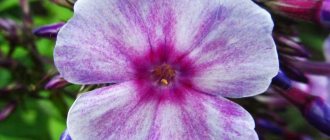Save our selection of the most common types and varieties of phlox in cultivation. We are sure that you will certainly find something for your garden in it!
Phlox are delightful flowers that amaze with a variety of shapes, sizes and shades. Among them there are bush and ground cover species, both spring and summer flowering. You can choose a variety with snow-white or variegated flowers. Whatever type or cultivar you choose, you can be sure of one thing - phlox will not disappoint you.
Phlox paniculata
This is perhaps the most common type of phlox, which can be found in almost every flower garden. It blooms all summer until early autumn, striking in color and filling the garden with a pleasant sweet aroma.
Paniculate phloxes are indispensable for misborders and borders. They can be safely planted in the most visible place, without worrying that the flowers will fade due to the heat and scorching sun. On the other hand, they bloom no less luxuriantly even in light shade.
It is important to consider that for good growth, paniculate phlox need good air circulation, so you should not plant them close to buildings. These plants should never be mulched in the summer.
Wherever you place this phlox bushes, you can be sure that bees and butterflies will constantly be circling around.
This is a bush type of phlox, which belongs to the tall group. Panicle phlox grow up to 1.2 m in height depending on the variety and prefer moderate watering and well-drained soil.
Amethyst
Spectacular phlox of medium height with fragrant inflorescences of a bluish-purple hue.
| Petal coloring | Bush height (cm) | Bush width (cm) | Flowering time |
| Bluish-purple | 80-90 | 30-60 | July August |
Blue Paradise
Blue Paradise is a paniculate phlox with charming bluish-lavender flowers that exude a pleasant light aroma. This cultivar is considered tall.
| Petal coloring | Bush height (cm) | Bush width (cm) | Flowering time |
| Bluish-lavender | 90-120 | 30-60 | July August |
Bright Eyes
A charming medium-growing phlox with a strong aroma. It is not afraid of fungal diseases and is unlikely to cause you any trouble in caring for it.
| Petal coloring | Bush height (cm) | Bush width (cm) | Flowering time |
| Soft pink | 45-60 | 30-60 | July August |
David
Luxurious snow-white phlox David received a prestigious award from British flower growers. This stately beauty grows well both in the sun and in partial shade, and practically does not get sick.
| Petal coloring | Bush height (cm) | Bush width (cm) | Flowering time |
| Snow-white | 90-120 | 30-60 | July August |
Delilah
A low plant with pinkish-purple flowers. Phlox varieties Delila are generally not capricious and resistant to various kinds of diseases, but can sometimes be susceptible to spotting.
| Petal coloring | Bush height (cm) | Bush width (cm) | Flowering time |
| Magenta | 50-60 | 30-50 | July-September |
Candy Twist
Candy Twist is a variety of paniculate phlox with playful striped colors reminiscent of a candy cane. This phlox is very fragrant, does not fade in the sun, and is disease resistant.
| Petal coloring | Bush height (cm) | Bush width (cm) | Flowering time |
| White and pink stripes | 45-60 | 60-70 | July-September |
Sandro Botticelli
A delightful variety of phlox selected by Yuri Reprev is deservedly named after the great Italian painter. Sandro Botticelli delights with its delicate lilac-pink color. You'd think it came straight from an artist's canvas.
| Petal coloring | Bush height (cm) | Bush width (cm) | Flowering time |
| Mauve | 70-75 | 60-70 | July August |
How to buy phlox at the Siberian Garden nursery
In our nursery, you can buy phlox seedlings on open trading floors and in nursery stores. For addresses, opening hours, and phone numbers of retail outlets, see the “Contacts” (in the top menu).
The Siberian Garden nursery delivers seedlings throughout Russia. You can order plants in our online store at: zakaz.sibsad-pitomnik.ru or follow the link in the top menu. You will also find information about the conditions for placing orders, paying for them and delivering seedlings throughout Russia in the online store in the relevant sections.
The Siberian Garden nursery sells seedlings wholesale and invites organizations involved in the sale of seedlings, landscape design, as well as organizers of joint purchases, to cooperate. The terms of cooperation can be found in the “Wholesalers” (in the top menu).
Spotted Phlox (Phlox maculata)
Spotted phlox is also often called meadow or pyramidal phlox. This is a very close relative of Phlox paniculata. You can distinguish spotted phlox from its more popular “brother” by two features: small burgundy spots on the stem and the pyramidal shape of the inflorescences.
Like other phloxes, plants of this species love moist, fertile soil and well-lit or partially shaded areas. It is worth considering that, unlike paniculate phloxes, spotted phloxes often suffer from powdery mildew and are susceptible to nematodes and spotting.
- Phlox diseases and their treatment
What diseases most often affect phlox, and how to deal with them?
Spotted phlox is not inferior in beauty to paniculata phlox, but not so many varieties have been bred.
Delta
One of the most common, proven varieties of spotted phlox.
| Petal coloring | Bush height (cm) | Bush width (cm) | Flowering time |
| Pinkish-white with a bright pink eye | 70-80 | 45-50 | July August |
Natasha
Natasha is one of the most famous varieties of spotted phlox. This is a beautiful pink and white striped flower. However, Natasha is a rather capricious little thing.
This phlox grows much slower than other cultivars of this species, and in bright sun it can fade, so it is advisable to plant it in partial shade.
| Petal coloring | Bush height (cm) | Bush width (cm) | Flowering time |
| Hot pink and white stripes | 70-80 | 40-50 | July August |
Omega
Phlox Omega is a worthy, beautiful, unpretentious flower for the garden. It can withstand temperatures below –20°C and grows quickly.
| Petal coloring | Bush height (cm) | Bush width (cm) | Flowering time |
| Snow-white with pinkish-purple eye | 80-90 | 40-50 | July August |
Rosalind
The Rosalind variety is about to turn one hundred years old - this flower has been grown in gardens since 1920. It usually blooms a couple of weeks earlier than most phloxes.
The only “cosmetic” drawback of the Rosalind phlox can be considered an insufficiently lush inflorescence. Therefore, it is usually planted in the background of mixborders.
| Petal coloring | Bush height (cm) | Bush width (cm) | Flowering time |
| Hot pink | 90-130 | 40-50 | End of June – August |
Planting methods
Annual phloxes can reproduce by self-sowing, but for perennials it is easier to choose cuttings
There are several ways to propagate phlox:
- seeds,
- cuttings,
- dividing the bush,
- layering.
The choice of option depends on when the grower plans to carry out the “operation”. Dividing the bush (it should be 4–5 years old) is best done in early spring, this gives the plant a good chance of rooting. If absolutely necessary, this can be done in early autumn, but only when the phloxes have finished flowering.
The plant is propagated by layering throughout the season, including in summer.
Propagation by cuttings (experts consider this method the most convenient) is carried out in the spring, when the soil has warmed up well enough, or in September, without waiting for the first frost, so that the phlox can prepare for the cold and take root firmly. The summer option of propagation by cuttings is chosen by those gardeners who visit their plot regularly, and not on visits - if the plant is not watered even for 2-3 days, it may die.
Sowing of seeds is carried out taking into account climatic conditions. If you sow planting material in open ground, daytime temperatures should not fall below +20°C, and night temperatures +12°C. It is possible to sow seeds before winter (in October - November), in this case the soil should be frozen, and the seeds should be covered with dry soil, excluding watering.
When growing seedlings at home, use disposable containers with drainage holes. Here's how to do it step by step:
- Purchase universal soil for seedlings from a specialized store (it is better if it contains vermicompost).
- Fill the soil into disposable containers to about 2/3 of their volume and level it.
- Disinfect the soil with a solution of phytosporin.
- The seeds are laid out on the surface of the soil and sprinkled with soil on top.
- Cover the containers with lids or spunbond, take them outside, place them on the ground, under the snow, so that the seeds undergo natural stratification within a week.
- The containers are returned to the house and the seedlings are grown in the usual way for flower crops, at an average temperature of +21°C.
There are other ways to grow phlox seedlings. For example, you can do this: soak the seeds and keep them moist for 2 weeks at room temperature (18 to 22°C). After this, add clean dry sand to the seeds, mix and place in the refrigerator for a week to undergo stratification. Then the planting material should be added to disposable containers, buried 1 cm into the soil.
For good development of seedlings, it is necessary to maintain a temperature regime in the range of +17...25°C.
Phlox will be ready for planting in open ground after they have 5-6 true leaves, and also if the threat of frost has passed outside.
The place must be completely ready for planting - loosened soil, abundant watering. Plants should be planted at a distance of half a meter from each other, since the phlox will have to spend several years in this place and for them, having grown, the crowded space will become disastrous.
Phlox divaricata
Phlox spreada is native to North America and is often called Phlox canadensis. Other names for this plant are forest phlox or wild blue phlox.
This is a medium-sized plant that is very different from the previous two types of phlox. The height of the splayed phlox is 20-50 cm. The color scheme of the petals is bluish-lilac, in delicate pastel colors.
This phlox loves well-fertilized soil, but at the same time is perfect for rockeries and rocky areas. It also has a strong sweet aroma and attracts many bees and butterflies.
Not many varieties of this perennial are grown in cultivation, but all of them are 100% worth the time and effort invested in caring for them.
Clouds of Perfume
Phlox Clouds of Perfume forms a turf up to 60 cm wide. In spring, it is dotted with a scattering of charming lavender flowers that fill the flower garden with their aroma.
Please note that this phlox is not resistant to powdery mildew and nematodes.
| Petal coloring | Bush height (cm) | Bush width (cm) | Flowering time |
| Lavender | 20-30 | 50-60 | April May |
Landen Grove (London Grove)
From a distance, the Landen Grove phlox bushes can be mistaken for a sea of forget-me-nots. But if you come a little closer, you will be covered with a cloud of subtle aroma that cannot be confused with anything else.
This perennial is quite resistant to powdery mildew, grows well and does not require special care.
| Petal coloring | Bush height (cm) | Bush width (cm) | Flowering time |
| Bluish-lavender | 30-35 | 50-60 | April May |
Fuller's White
White bushes of Fullers White will be an excellent decoration for a spring mixborder.
This phlox is notable for its excellent winter hardiness - it can withstand frosts down to –40°C.
| Petal coloring | Bush height (cm) | Bush width (cm) | Flowering time |
| White with a slight purple tint | 30-35 | 15-30 | April May |
Eco Texas Purple
Phlox Eco Texas Purple is notable for its spectacular dark lilac flowers. It differs from most spreading phlox cultivars in its later flowering period - from late spring to early summer.
| Petal coloring | Bush height (cm) | Bush width (cm) | Flowering time |
| Purple with pink eye | 30-35 | 15-30 | May June |
Diseases and pests
Phloxes are not threatened by diseases if you take good care of them and do not neglect your planting.
One of the most common diseases that spoils the appearance of this perennial is powdery mildew, which covers the leaves and stems with a white coating. This disease can overcome the plant in mid-July. If no action is taken, the diseased leaves will begin to dry out and fall off. To avoid this disease, plants must be treated with one percent Bordeaux mixture or copper sulfate solution of the same concentration in October. At the beginning of summer, spray the plants with fungicidal preparations.
If you notice signs of the disease, namely a white coating, then the plants must be treated with Bordeaux mixture. Repeated treatment is carried out after 7-10 days.
In addition, aphids are dangerous for plants, but they only attack weakened flowers. Therefore, avoid lack of nutrition and water them on time. Among the pests of phlox, earwigs, spider mites, and wireworms should also be noted.
As you can see, this beautiful perennial plant does not cause any particular difficulties in care and will not require much attention from you. At the same time, these bright, fragrant flowers can become the best decoration of the garden and a wonderful addition to your flower arrangement. They are very unpretentious, but they bloom very luxuriantly and profusely, especially if you feed them.
Phlox stolonifera
Phlox stoloniferous is a ground cover species that is often called creeping phlox. Its homeland is the American Appalachians, so it is accustomed to harsh climates and is ultra-winter-hardy.
Like other phloxes, perennials of this species grow well in moist, humus-rich soils and love rocky areas.
Phlox stoloniferous grows quickly, forming dense mats up to 20 cm high. It practically does not get sick, does not have any special care requirements, and prefers partial shade.
Breeders have managed to develop few varietal stoloniferous phloxes, but they pleasantly surprise with their variety of colors.
Bruce's White
Bruce White is a variety of white-flowered phlox stoloniferous. Its flowering occurs in mid to late spring. This is a “titled” phlox that received a prestigious award from American breeders.
| Petal coloring | Bush height (cm) | Bush width (cm) | Flowering time |
| Snow-white | 15-20 | 20-60 | April May |
Home Fires
The bright pink phlox Home Fires does not mind good lighting and does not fade in direct sunlight. It prefers moderate moisture, but can easily be considered a drought-resistant perennial.
| Petal coloring | Bush height (cm) | Bush width (cm) | Flowering time |
| Pink | 15-20 | 20-60 | April May |
Sherwood Purple
Phlox Sherwood Purple will add bright colors to a shaded corner of the garden. Feel free to plant it in the tree trunks of trees and large shrubs - it quickly forms a fluffy purple-green mat.
| Petal coloring | Bush height (cm) | Bush width (cm) | Flowering time |
| Bluish-purple | 15-20 | 20-60 | July August |
Description
Many varieties of phlox are known in the world. More than forty species have been domesticated. And there are several hundred varieties and hybrids. In the wild it grows on rocky slopes and in crevices and sandy hills. You can also find it in the shade of bushes if the place is well lit.
The plant is a spreading bush, covered with narrow, elongated and pointed leaves.
Loose or dense turf, which is formed by the root system of a plant, can quickly increase in volume. Before flowering, the cushion of the bush (resembles a hummock of moss) can reach only 8-10 centimeters in height. Next, small peduncles appear, on which there are up to two corollas, collected in inflorescences.
The height of the bush becomes 15-20 centimeters.
Umbrellas of inflorescences contain up to 7-8 flowers, they can also be single. Their diameter is 2.5-3 centimeters. Phlox petals come in different shades of color, similar to candy canes, and are deeply cut or heart-shaped.
Creeping phloxes, with awl-shaped leaves, are very popular with summer residents. These flowers are known for their numerous varieties, offering a magnificent variety. Long flowering (from mid-May to September), sometimes twice a season, only adds to its popularity.
Phlox subulata
Flowers of this species boast the most luscious colors among all low-growing phloxes. They come in bright pink, lavender, lilac, crimson, red, purple, snow-white and even variegated. In a word, for every taste and color.
Subulate phloxes do not require special care, do not cause problems, do not get sick, and quickly grow into dense, voluminous mats.
It is best to plant them in well-lit areas. They are suitable for rock gardens and rock gardens and require well-drained soil.
The height of the awl-shaped phlox bushes does not exceed 15 cm. This is the shortest phlox that is grown in cultivation.
Bonita
This phlox is not afraid of the most severe frosts and sweltering heat. Its bright pink flowers will brighten any border along a garden path.
| Petal coloring | Bush height (cm) | Bush width (cm) | Flowering time |
| Pink with purple eye | 10-15 | 45-60 | July August |
Candy Stripes
Candy Stripes is one of the most variegated varieties of awl-shaped phlox. Its petals have a distinctive bright pink stripe in the center, a white border around the edges and a dark purple spot at the base.
Like other subulate phloxes, this cultivar is frost-hardy and loves good light and well-drained soil.
| Petal coloring | Bush height (cm) | Bush width (cm) | Flowering time |
| White and pink stripes with a purple eye | 10-15 | 60 | May June |
Rules for creating flower borders
A flowering border , which will delight the eye throughout the summer season, is formed from several types of plants. Small-bulbous and bulbous the first to bloom in spring .
They are planted closer to the edge of the path, followed by a strip of herbaceous plants that bloom in summer. Low-growing crops that will bloom in the fall are placed along the outer perimeter of the border.
Now in more detail :
- In the first row bulbous perennials are planted - crocuses, snowdrops, hyacinths, daffodils, tulips. The path will also be decorated with ground cover creeping plants - phlox , periwinkle , grass carnation . Here you can plant peppermint and spearmint, thyme , and basil. Fragrant herbs grow quickly and are used as spices;
- The middle- height row of roadside ridges is filled with low-growing perennial flowers . Hosta , bergenia , matricaria , and chrysanthemum are suitable for these purposes . Unpretentious perennial plants will cover the departed primroses with their leaves and shoots;
- The completion of the border composition will be low-growing ornamental shrubs - border rose , garden lingonberry Japanese spirea barberry . Their height should not exceed 40 cm so as not to obscure the view of the flower beds and landscape compositions on the site.
When decorating a border, you should select plants according to color scheme . It can be designed in shades of the same color or in contrasting combinations. To ensure that the harmonious lines of the pattern are not interrupted, the plants are planted close to each other.
Caring for perennial plants in a border composition
Perennial ornamental crops need proper care :
- Regular watering;
- Treatment against diseases and pests . For example, spraying plants with Bordeaux mixture;
- Loosening and mulching the soil;
- Sheltering young plants for the winter.
Tip: To evenly moisten the soil along the border, use a drip irrigation system.
The main problem of perennials in a limited space is their constant growth and reproduction . In order for the border to look the same every year, it is necessary to promptly plant overgrown flowers, dig up bulbs and trim shrubs.
Read more about whether you need to prune perennial flowers for the winter here.
What perennial flowers are planted before winter can be found in the following article.
The orderly beauty of border compositions and roadside edgings depends on proper planning and thoughtful selection of ornamental plants. Symmetry, color harmony and well-groomed appearance of borders emphasize the beauty of the garden and create a unique frame for each part of it.
6sotok-dom.com
Border perennials. What types of border perennials are there?
Tatiana Surovaya
Tenacious (ayuga), jasmine, chickweed, woolly chickweed, awl-shaped phlox.
Valentina Timofeeva
maybe like this
pavyrp yvra
Almost any perennials can be used as border plants, it all depends on the height and density of the border you want to get. I use sedums: Kamchatka, bent, awl-shaped, prominent, flower-bearing hosts, reichers, thymes, cloves and much more, even different types of onions: Onion (Chives) and Slime Onion. Borders made from various varieties of euonymus fortunea look very good. Only tall plants such as paniculate phlox, for example, are probably not suitable for borders, but subulate phlox is ideal for these purposes. The choice is very rich and it all depends on what you want to get. You can choose plants that vary in color and texture.
Valentina Grigorieva
Or maybe just daisies.
Elena Orlova
carnations, herbs, for example, perennial alpine asters, arabis, yellow alyssum, bergenia, speedwells (there are creeping ones, there are low-growing ones), bellflowers (Carpathian for example), soapwort, fescue, low chamomile (for example, princess OTNK no higher than 20-30 cm), chickweeds. cymbalarias, border chrysanthemums, red low-growing gaillardia. astilbe nizia, hosta. stahis. bryozoans. heathers, and I can name you a hundred other species
Dina
Boxwood suited me well as a border; it overwinters just at the level of the snow cover
Fomina
I have a path in my garden. These are there.
Photo from October 20.
panina
Plant a herb clove, it grows in a clump - then cut it into strips and plant it. She has a lot of colors
You can sow Matricaria, only it will then be scattered throughout the garden, but it is easily pulled out
I also like awl-shaped phlox, there are also enough colors
or saxifrage
or a peg
Only all these plants do not bloom for long. But they have very decorative foliage and cute pads. Although hostas look beautiful, I like annuals better. And every year it’s new.











